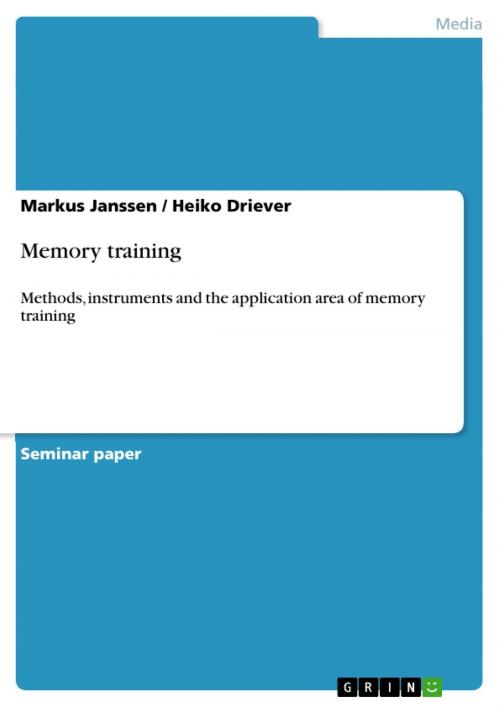Memory training
Methods, instruments and the application area of memory training
Nonfiction, Reference & Language, Language Arts, Communication| Author: | Markus Janssen, Heiko Driever | ISBN: | 9783638530019 |
| Publisher: | GRIN Publishing | Publication: | August 3, 2006 |
| Imprint: | GRIN Publishing | Language: | English |
| Author: | Markus Janssen, Heiko Driever |
| ISBN: | 9783638530019 |
| Publisher: | GRIN Publishing |
| Publication: | August 3, 2006 |
| Imprint: | GRIN Publishing |
| Language: | English |
Seminar paper from the year 2005 in the subject Communications - Miscellaneous, grade: 1,0, niversity of Applied Sciences Oldenburg/Ostfriesland/Wilhelmshaven; Emden, course: Communication & Presentation, 17 entries in the bibliography, language: English, abstract: The memory is like a muscle! Train this muscle and it gets better and better. 'Memory Training' helps to improve the memorizing function of brain. The tools which 'Memory Training' uses are called mnemonics . The main application area of 'Memory Training' is the realm of the learning process. This is one of some suitable definitions and confines of 'Memory Training'. The definition only shows a short raw outline of the topic 'Memory Training'. Besides, along this written assignment, the writers try to point out the methods, instruments and the application area of 'Memory Training'. The paper will give information about methods and instruments of 'Memory Training,' but what about the aims of 'Memory Training'? The aims of 'Memory Training' normally are individual aims. Those like: easy learning of new foreign languages; the interest to improve the general education; 'never again forgetting of birthdays' or telephone numbers; to hold presentations and speeches without any help (of cheat sheet) or only to improve the memory performance to register information faster? Therefore, the aims of 'Memory Training' are not significant for the present written assignment. The following elaboration begins with the structure and the functions of the human brain, how it works, the process of memorizing and lastly the collaborations of the left and right hemisphere. The next realm of 'Memory Training' points out the different kinds of mnemonics. There are a lot of different methods, the writers only point out the main methods for 'Memory Training'. An important partition of the mnemonics is the importance of optimizing outside influences in relation to the mnemonics and the learning process. What kind of basic possibilities exist to minimize them? The last part of the main body is the subtopic 'Easy Learning' which acts about methods and instruments to learn easier. Besides the mnemonics which are already important instruments the authors describe further methods and instruments to learn easier. The topic 'Memory Training' raises some questions like what is my profit, when can I see the first prosperities and why do companies instruct their people in using mnemonics?
Seminar paper from the year 2005 in the subject Communications - Miscellaneous, grade: 1,0, niversity of Applied Sciences Oldenburg/Ostfriesland/Wilhelmshaven; Emden, course: Communication & Presentation, 17 entries in the bibliography, language: English, abstract: The memory is like a muscle! Train this muscle and it gets better and better. 'Memory Training' helps to improve the memorizing function of brain. The tools which 'Memory Training' uses are called mnemonics . The main application area of 'Memory Training' is the realm of the learning process. This is one of some suitable definitions and confines of 'Memory Training'. The definition only shows a short raw outline of the topic 'Memory Training'. Besides, along this written assignment, the writers try to point out the methods, instruments and the application area of 'Memory Training'. The paper will give information about methods and instruments of 'Memory Training,' but what about the aims of 'Memory Training'? The aims of 'Memory Training' normally are individual aims. Those like: easy learning of new foreign languages; the interest to improve the general education; 'never again forgetting of birthdays' or telephone numbers; to hold presentations and speeches without any help (of cheat sheet) or only to improve the memory performance to register information faster? Therefore, the aims of 'Memory Training' are not significant for the present written assignment. The following elaboration begins with the structure and the functions of the human brain, how it works, the process of memorizing and lastly the collaborations of the left and right hemisphere. The next realm of 'Memory Training' points out the different kinds of mnemonics. There are a lot of different methods, the writers only point out the main methods for 'Memory Training'. An important partition of the mnemonics is the importance of optimizing outside influences in relation to the mnemonics and the learning process. What kind of basic possibilities exist to minimize them? The last part of the main body is the subtopic 'Easy Learning' which acts about methods and instruments to learn easier. Besides the mnemonics which are already important instruments the authors describe further methods and instruments to learn easier. The topic 'Memory Training' raises some questions like what is my profit, when can I see the first prosperities and why do companies instruct their people in using mnemonics?















